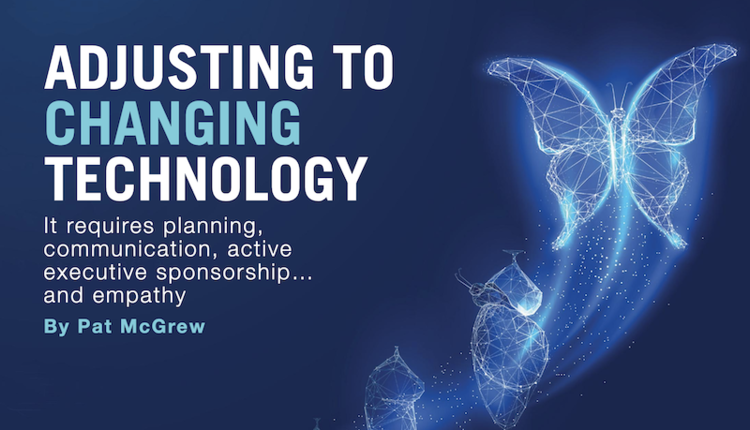
Digital transformation is a hot topic. Articles in magazines and sessions at conferences have examined what it means to execute a digital transformation while keeping the business running. Most advisors agree that you should start with an assessment of your people, processes and technology to develop a solid foundation for any change you undertake. That assessment will expose priorities and the members of the team who will be your champions. Resistors and saboteurs will also become evident and make it clear why 70% of transformation and change projects fail.
That number originated in a study Harvard Professor John Kotter led in the 1990s. Search on his name and the 70% number, and you will find a laundry list of references to his work. Is it still valid? In September 2021, the Harvard Business Review added a new article to the conversation with data gathered by Copperfield Advisory (Copperfield), Insider and Revolution Insights Group (RIG). Their work found a 78% failure rate and reiterated most of the points of failure seen by Kotter more than 25 years ago. The takeaway is that change is hard, staff and management may resist the very change they say they need, and changing technologies make it more difficult, not easier.
Why It's Hard
Look around your workspace. There is technology everywhere. Laptops, tablets, phones, assistant devices (Alexa, Bixby, Siri, Google) and smart automation solutions at home put us face to face with technology stacks. Just updating a phone can be a mind-bending experience because we aren't sure our favorite apps will work the same way. New Windows and MAC updates create the same concern, and changes to the software sitting on those platforms bring a mix of excitement and dread.
Now take that change to the office — brick-and-mortar or remote — and the reason change causes concern emerges. Change in the office takes employees and managers out of their comfort zones. Talk of automation raises the specter of changing job roles. Replacing homegrown program code and scripts with automation suites sounds like a plot to eliminate programming staff. Integrating systems to update business and production dashboards continuously changes the office dynamic. Adding new equipment that brings new capabilities and capacity can seem intimidating to the daily cadence.
These are the evergreen reasons that adjusting to changing technology requires planning, communication and active executive sponsorship. Add the global experience of the last two years to the mix, and we have an additional ingredient to add to the recipe. Microsoft CEO Satya Nadella said it best: we need empathy. He found it lacking when he took over Microsoft, and it became a thread he wove through transformation he sponsored. Streamlining and automating, changing the metrics and rethinking management structure to support new goals were important. But without empathy for everyone in the chain, there would be no success.
Help Everyone Adjust
For every project to change processes and technology, you need a plan. It needs to be more than a set of bullets in a slide deck. It needs to be a living plan that considers every touchpoint in the organization and clearly states what is changing, why it is changing and its impact on specific jobs and processes.
Make sure that everyone knows what technology you have, how it works, who holds responsibility for maintaining it, and each technology's role on the other side of a transformation project. If you haven't done a process and technology assessment to codify what you have, how old or new it is, and its current state, do that before you try to make everyone comfortable. The assessment may point out technology that puts the business at risk due to age or other issues. It may also identify technology that can remain in place a bit longer because it's been kept current.
Find your unofficial leader in each team. It may not be the manager or director. It may not be the longest-tenured person. Find the person everyone goes to and has confidence in, and make sure they understand the changes. It's even better if they can be an influencer with their teams.
Build a plan that allows for adjustment. Help everyone understand that some of the programs may need to change. Technology implementations tend to take some time. Processes need to migrate. New connections and data feeds may take some time and will require review to ensure that the correct data is fed into the workflow. Timing may need to change for cutover to new systems. Planned integrations may hit roadblocks.
Find outlets for everyone to express concerns, and take them seriously. Consider approaching changing technology with an open mind. Make it safe for everyone to offer suggestions and point out problems. Bring everyone to the table, but measure and test along the way. Fast failure is an option.
Finding the Balance
Moving from manual to automated systems, or even islands of automation, requires giant leaps of faith, but it pays off for the business. Homegrown systems and manual processes put the business at risk. Many companies learned this when they had to close offices and ask their teams to work from home. The companies that had invested in automating their business and production workflows found it easier to handle work-in-progress and new work than those who relied on people moving paper from process to process. Organizations that invested in integrating their systems to use common, normalized data pools to inform commonly accessible dashboards were better positioned to adjust decisions in real-time.
The path forward that mitigates risk and positions companies for growth is to embrace automation. Helping everyone adjust to the changes it brings is conducive to continued success.
A Helpful Checklist
Use this checklist to ensure your change and transformation projects don't leave your team dazed and confused:
- Assess your current state at the macro- and micro-levels.
- Identify key stakeholders and unofficial leaders.
- Create an event plan to keep everyone informed and provide a forum for concerns.
- Define the project plans and communicate them to everyone, even those not initially impacted.
- Define a strategy for repurposing staff and identifying their growth path.
- Identify your metrics and be faithful about capturing data and sharing the analysis.
- Be ready to pivot if part of the plan is not producing the needed results.
- Remember that failure is an option; do it fast and get past it.
- Document and test every change.
- Celebrate every success.
Pat McGrew helps companies perform better in the print hardware, software and printing services industries. An experienced professional speaker and co-author of 8 industry books, editor of A Guide to the Electronic Document Body of Knowledge, and regular writer in the industry trade press, Pat won the 2014 #GirlsWhoPrint Girlie Award for dedication to education and communication in the industry, and the 2016 Brian Platte Lifetime Achievement Award from Xplor International. She is certified as a Master Electronic Document Professional by Xplor International, with lifetime status, and as a Color Management Professional by IDEAlliance. Pat also serves on the DOCUMENT Strategy Advisory Board.











